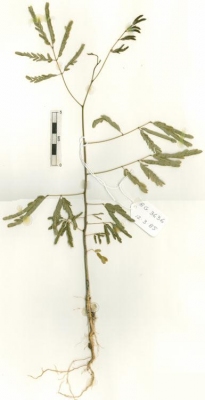Albizia retusa
Benth.
Fabaceae
Albizia littoralis Teijsm. & Binn.
Clypearia maritima Rumph.
Common Name:
General Information
Albizia retusa is a tree. There are two main forms - subspecies retusa grows up to 25 metres tall with a short, often crooked bole that is unbranched for only around 3 metres and can be 70cm in diameter[
451- Title
- Flora Malesiana Series 1
- Publication
-
- Author
- Various
- Website
- http://www.archive.org
- Publisher
- Nationaal Herbarium Nederiand, Universiteit Leiden branch
- Year
- 0
- ISBN
-
- Description
- A massive treatment of the plants of the Malaysian Archipelago. Much of it has been made available to download from the Internet
]. Subspecies morobei grows up to 39 metres tall with a straight bole that can be unbranched for up to 18 metres[
451- Title
- Flora Malesiana Series 1
- Publication
-
- Author
- Various
- Website
- http://www.archive.org
- Publisher
- Nationaal Herbarium Nederiand, Universiteit Leiden branch
- Year
- 0
- ISBN
-
- Description
- A massive treatment of the plants of the Malaysian Archipelago. Much of it has been made available to download from the Internet
].
The seeds have been used locally as beads. The wood has potential for use.
Known Hazards
None known
Botanical References
451- Title
- Flora Malesiana Series 1
- Publication
-
- Author
- Various
- Website
- http://www.archive.org
- Publisher
- Nationaal Herbarium Nederiand, Universiteit Leiden branch
- Year
- 0
- ISBN
-
- Description
- A massive treatment of the plants of the Malaysian Archipelago. Much of it has been made available to download from the Internet
Range
E. Asia - Thailand, Malaysia, Indonesia, Philippines, southern Japan, to New Guinea, Australia and the western Pacific.
Habitat
Ssp retusa is found by the coast on sandy beaches, mangrove; lowland rain forest subject to flooding; coral sand. Ssp morobei is found in rain forest, secondary regrowth on alluvial soils at elevations up to 810 metres[
451- Title
- Flora Malesiana Series 1
- Publication
-
- Author
- Various
- Website
- http://www.archive.org
- Publisher
- Nationaal Herbarium Nederiand, Universiteit Leiden branch
- Year
- 0
- ISBN
-
- Description
- A massive treatment of the plants of the Malaysian Archipelago. Much of it has been made available to download from the Internet
].
Properties
| Other Uses Rating |      |
| Habit | Tree |
| Height | 30.00 m |
| Pollinators | Bees, Insects |
| Cultivation Status | Wild |
Cultivation Details
This species has a symbiotic relationship with certain soil bacteria; these bacteria form nodules on the roots and fix atmospheric nitrogen. Some of this nitrogen is utilized by the growing plant but some can also be used by other plants growing nearby[
1309- Title
- The Leguminosae; A Source Book of Characteristics, Uses and Nodulation
- Publication
-
- Author
- Allen O.N.; Allen E.K.
- Publisher
- University of Wisconsin
- Year
- 1981
- ISBN
- 0-333-32221-5
- Description
- An amazing and comprehensive work, giving a brief guide to the many genera of the family Fabaceae and also the principle uses of the genus.
].
Edible Uses
None known
Medicinal
None known
Other Uses
The seeds have been used as beads[
451- Title
- Flora Malesiana Series 1
- Publication
-
- Author
- Various
- Website
- http://www.archive.org
- Publisher
- Nationaal Herbarium Nederiand, Universiteit Leiden branch
- Year
- 0
- ISBN
-
- Description
- A massive treatment of the plants of the Malaysian Archipelago. Much of it has been made available to download from the Internet
].
The heartwood is dark brown; the sapwood yellowish brown. The wood is moderately hard and heavy[
451- Title
- Flora Malesiana Series 1
- Publication
-
- Author
- Various
- Website
- http://www.archive.org
- Publisher
- Nationaal Herbarium Nederiand, Universiteit Leiden branch
- Year
- 0
- ISBN
-
- Description
- A massive treatment of the plants of the Malaysian Archipelago. Much of it has been made available to download from the Internet
].
Propagation
Seed - it has a hard seedcoat and may benefit from scarification before sowing to speed up germination. This can usually be done by pouring a small amount of nearly boiling water on the seeds (being careful not to cook them!) and then soaking them for 12 - 24 hours in warm water. By this time they should have imbibed moisture and swollen - if they have not, then carefully make a nick in the seedcoat (being careful not to damage the embryo) and soak for a further 12 hours before sowing.
If you have any useful information about this plant, please leave a comment. Comments have to be approved before they are shown here.

 Useful Tropical Plants Database 2014 by
Ken Fern,
web interface by
Ajna Fern
with help from
Richard Morris.
Useful Tropical Plants Database 2014 by
Ken Fern,
web interface by
Ajna Fern
with help from
Richard Morris.